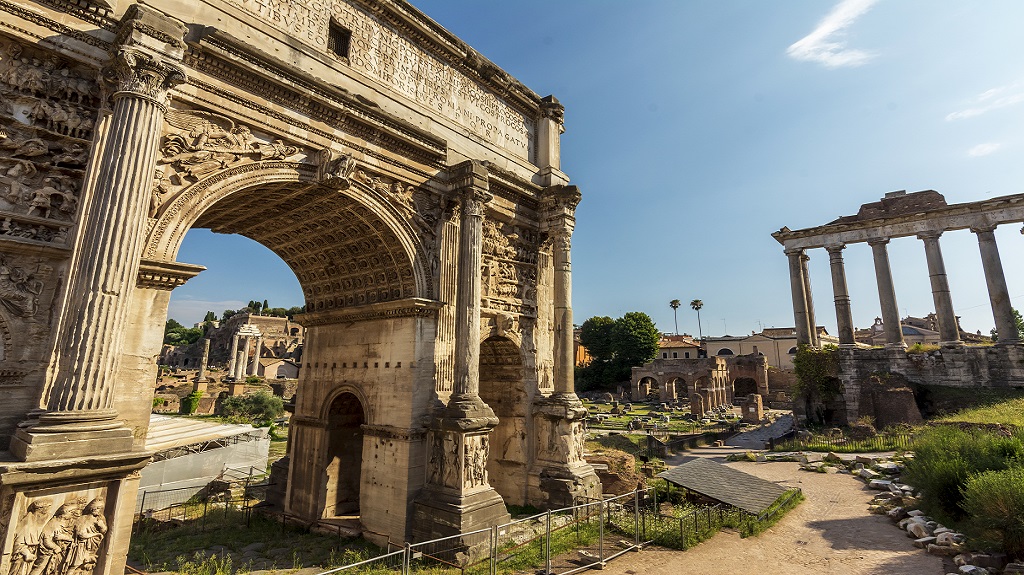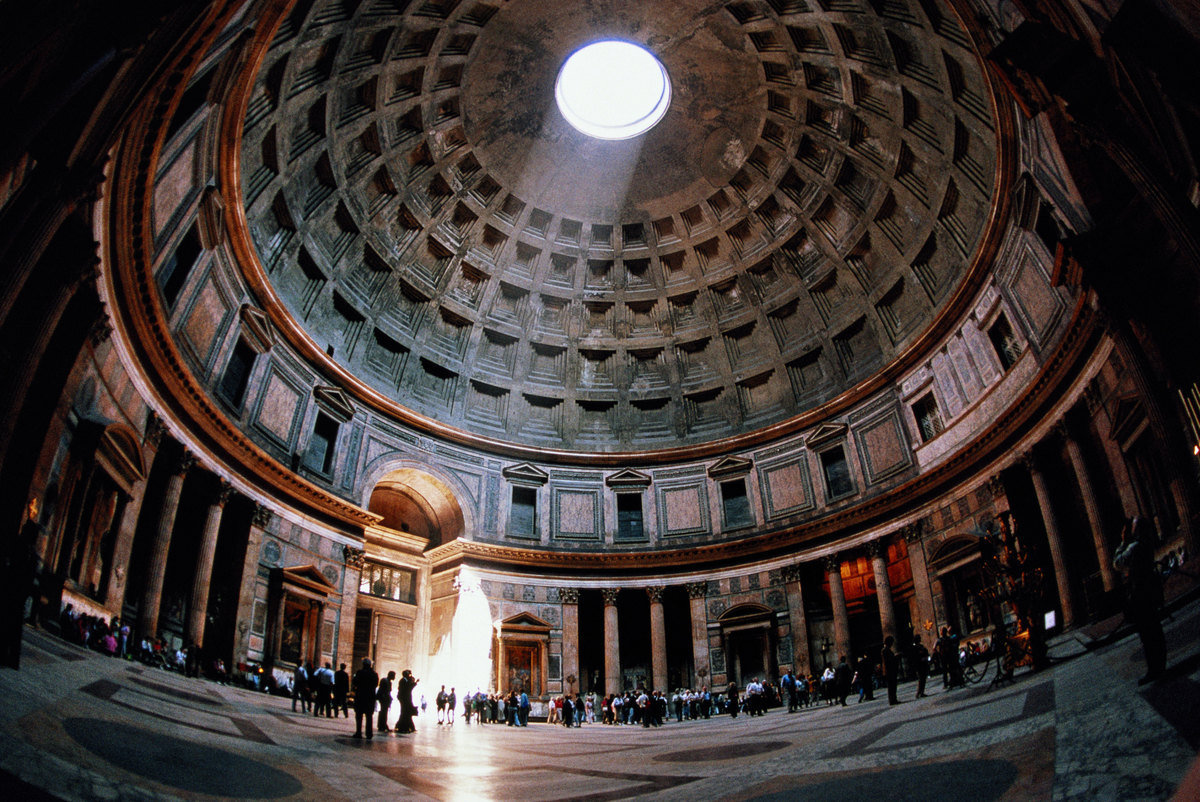
By Zen Lynch

The Colosseum
In 2013, the Italian Ministry of Culture and Tourism partnered with luxury leather goods manufacturer, Tod’s, to fund a major $35 million renovation of the Colosseum. Using nebulized water, teams of artisans and archeologists spent nearly three years meticulously cleaning this 2000-year-old monument. The renovation has resulted in a lighter and brighter structure. The shade of the newly cleansed travertine has been variously described as ivory, oatmeal, or Haitian cotton. While thousands of workers, most of them slaves, are said to have built the Colosseum, the restoration team numbered only 30! The Roman engineering skills of applying the use of concrete and the rounded arch is certainly on display on a grand scale in the Colosseum, with its construction begun in 72 AD. To mark the Colosseums completion in 80 AD, Vespasian’s son and successor, Titus, held games that lasted 100 days and nights, during which it is believed 5,000 animals were slaughtered.
We also recommend a visit to the subterranean areas beneath the Colosseum and the Terzo Ordine (upper level (third tier) of the Colosseum). The third tier of the Colosseum offers a unique vantage point from which the entire auditorium, the valley of the Colosseum, Roman Forum, and Palatine, can be seen. Before reaching the third tier, you will pass through the only preserved tunnel, including some of the original plaster and original skylight, which connects the second tier to the third. The special underground visit is led by one of the museum’s own guides and lasts roughly an hour and a half. Please note there is limited availability of only 25 people per group (including your private guide).
Please note you have the option of a private night tour of the Colosseum, including the tunnels where the gladiators awaited their contests. Delicious lunch option – Alle Carrette Pizzeria. Kudos to Rick Steves for recommending rustic Alle Carrette for great pizza. Located just beyond the Colosseum, this place oozes with local Roman authenticity.

Ponte Rotto Bridge
The Ponte Rotto Bridge is only an approximately 15-minute walk from the Colosseum. Though many other sites capture the big crowds, we feel Ponte Rotto (“Broken Bridge”) is one of Rome’s greatest treasures, representative of the Roman Empire’s most impressive building achievements.
Constructed in 179 BC, it is Rome’s oldest bridge and one of the few surviving examples of Roman Republican architecture. It linked the cattle market, the Forum Boarium on the eastern bank, with Trastevere on the western one. Crossing it hasn’t been possible since Christmas Eve 1598 when its eastern span foundered in a violent torrent. Broken, it became one of Rome’s most recognizable landmarks, a picturesque ruin painted by artists from the 17th through the 19th-century, a poignant symbol of a grandeur that once had been. The bridge’s original name was the Pons Aemilius (the Emilian Bridge), after one of the two men who built it, Aemilius Lepidus (Emilio Lepido), leader of the Roman Senate and Pontifex Maximus, the co-censor Fulvius Nobilior. Previously, Rome’s bridges had been made of wood and supported on timber piles driven deep into the riverbed. The new Pons Aemilius, by contrast, consisted of a wooden roadbed supported on five stone piers and embodied multiple feats of innovative engineering.

The Imperial Forum(s)
The Imperial Forum is just a short walk from the Colosseum. Being big ancient Roman history buffs, we feel the relatively small area of land occupying Imperial Forums represents a historical snapshot of the politics, religion, and commerce of ancient Rome. Romans first began meeting in the original Forum around 500 BC, at the time of the founding of the Roman Republic. Over the centuries, wealthy aristocrats added temples, statues, and triumphal arches to the Forum incrementally. By 46 BC, the Forum became too crowded, hence, the intervention of Julius Caesar in building the additional Forum adjacent to the original one. You may notice big, pink cement blocks with the current ruins – this is where the temple of Venus once stood. Later, Emperor Augustus added another forum near the one conceived by Julius Caesar. Following the eventual fall of Rome, the area became a pasture. Though the site today is scattered with small fragments of the huge buildings that once stood there, the main street, the Via Sacra can still be seen running through the heart of the Forum. Imagining Emperors walking through the same grounds we walked as tourists truly shakes our imagination.

The Pantheon
Being in continuous use for over 2000 years, the Pantheon is Rome in a microcosm, embodying the city’s pagan and Christian identities. Built in the second century by Emperor Hadrian (126 AD) as a temple to all the Roman gods, it is the only major work of Roman Imperial architecture still intact. The largest masonry dome ever built – 142 feet in diameter and weighing five thousand tons – it is the paterfamilias of every structure like it erected since. At the top is one of the most famous features in architecture, the Oculus. It focuses a circle of light into the Pantheon that, tracking the transit of the sun, passes slowly across the interior surfaces as the day progresses.
Other Pantheon Fun Facts
- Until the 20th-century, the Pantheon was the largest concrete structure in the world. Michelangelo studied its great dome before starting work on the dome of St. Peter’s Basilica.
- The Pantheon was originally built in 27 – 25 BC by the magistrate Marcus Agrippa (his name appears on the inscription outside), to commemorate the victory of Actium over Antony and Cleopatra. This original temple burned down in 80 AD.
- The Pantheon was completely reconstructed in 125 AD by Hadrian, a cosmopolitan emperor who had traveled widely in the East. The second temple was dedicated to every known god, from which the Pantheon gets its name. Hadrian himself is credited with the basic plan, an architectural design that was unique for the time.
- The Pantheon was maintained and restored by the emperors Septimus Severus (193 – 211) and Caracalla (211 – 217). During its two centuries as a functioning temple, statues of gods filled the niches. Animals were sacrificed and burned in the center, with the smoke escaping through the only means of light, the Oculus.
- After Christianity replaced paganism in Rome, the Pantheon was abandoned for a time. Public pagan worship was prohibited in 346 AD and most pagan temples were closed in 356 AD. Fortunately, a decree of 408 AD ordered that temples were to be put to a new use; thus some have been preserved and were used as secular buildings.
- The Pantheon remained unused until the Byzantine emperor Phocas (602 – 610) gave it to Pope Boniface IV (608 – 615). in 609 AD, the Pantheon was consecrated as a Christian church. It was the first pagan temple in Rome to be Christianized, although the practice had been common in the East since the 4th-century. The church was dedicated to the Virgin Mary and all the martyrs, thus continuing the tradition of a “catch-all” place of worship.
- In the 16th-century, Michelangelo came to the Pantheon to study its dome before he began work on the dome of St. Peter’s (whose dome is two feet smaller), and the Pantheon’s roof was stripped of bronze for use in Berini’s Baldacchino in St. Peter’s. In 1563, the bronze doors were restored.
- The bronze doors leading into the building (which are original and were once covered in gold) weigh 20 tons each. The walls of the Pantheon are 7.5 m (25 feet) thick.
- Monumental tombs are set into the walls of the Pantheon, including that of the artist Raphael (on the left side as you enter). Vittorio Emanuele II, the first king of a unified Italy, and his successor, Umberto I, are interred here as well.
- In the plaza outside the Pantheon is a lovely fountain topped by an ancient Egyptian obelisk. The obelisk and its base were erected by Pope Clement XI.